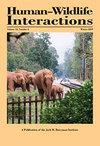Viewing Bornean Human–Elephant Conflicts Through an Environmental Justice Lens
IF 0.9
4区 环境科学与生态学
Q4 BIODIVERSITY CONSERVATION
引用次数: 2
Abstract
: Sabah, on the northeastern corner of Borneo, is concurrently Malaysia’s largest producer of oil palm ( Elaeis guineensis ) and home to the endangered Bornean elephants ( Elephas maximus borneensis ; elephants). Concomitantly, Sabah has been experiencing increasing and unsustainable human–elephant conflicts (HECs), which have not been thoroughly investigated from a human dimensions standpoint. To address this void, in March 2019, we conducted semi- structured interviews with 37 villagers located in the Sabah districts of Lahad Datu, Tawau, and Telupid to investigate villager cognitions regarding elephants, behaviors toward elephants, the formal and informal village institutions employed to mediate HECs, and the future viability of human–elephant coexistence. Respondents highlighted emotions of fear, anger, and frustration over crop and property damage that villagers were unable to effectively mitigate employing traditional institutions and strategies. Although negative emotions were somewhat tempered by the cultural significance of elephants, respondents indicated that coexistence with elephants remains challenging and is likely only viable under certain conditions: domestication of elephants, if elephants no longer destroyed crops, and/or if elephants were provided separate forested habitat away from humans. Our results demonstrated that elephant conservation in Sabah is viewed as a “not in my backyard” claim, which can hint at the presence of environmental injustice. We further examined Sabah HECs using an environmental justice framework and concluded that HEC as an environmental justice problem requires traditional fixes to be merged with more extensive, sustainable solutions that improve stakeholder agency.从环境正义的角度看婆罗洲人象冲突
:位于婆罗洲东北角的沙巴,既是马来西亚最大的油棕产地(Elaeis guineensis),也是濒临灭绝的婆罗洲象(Elephas maximus borneensis;大象)。与此同时,沙巴一直在经历越来越多和不可持续的人象冲突,这些冲突尚未从人的角度进行彻底调查。为了解决这一空白,2019年3月,我们对位于拉哈德拿土、打湖和特鲁皮德沙巴地区的37名村民进行了半结构化访谈,以调查村民对大象的认知、对大象的行为、用于调解hec的正式和非正式村庄机构,以及人象共存的未来可行性。受访者强调了村民无法利用传统制度和策略有效减轻对作物和财产损失的恐惧、愤怒和沮丧情绪。尽管负面情绪在一定程度上被大象的文化意义所缓和,但受访者表示,与大象共存仍然具有挑战性,并且可能只有在某些条件下才可行:驯化大象,如果大象不再破坏庄稼,和/或如果大象被提供远离人类的单独森林栖息地。我们的研究结果表明,沙巴的大象保护被视为“不要在我的后院”的主张,这可能暗示了环境不公正的存在。我们使用环境正义框架进一步研究了沙巴高等商业中心,并得出结论,高等商业中心作为一个环境正义问题,需要将传统的解决方案与更广泛、可持续的解决方案相结合,以改善利益相关者的代理。
本文章由计算机程序翻译,如有差异,请以英文原文为准。
求助全文
约1分钟内获得全文
求助全文
来源期刊

Human–Wildlife Interactions
Environmental Science-Nature and Landscape Conservation
CiteScore
2.80
自引率
0.00%
发文量
0
审稿时长
11 weeks
期刊介绍:
Human–Wildlife Interactions (HWI) serves the professional needs of the wildlife biologist and manager in the arena of human–wildlife conflicts/interactions, wildlife damage management, and contemporary wildlife management. The intent of HWI is to publish original contributions on all aspects of contemporary wildlife management and human–wildlife interactions with an emphasis on scientific research and management case studies that identify and report innovative conservation strategies, technologies, tools, and partnerships that can enhance human–wildlife interactions by mitigating human–wildlife conflicts through direct and indirect management of wildlife and increased stakeholder engagement. Our intent is to promote a dialogue among wildlife professionals concerning contemporary management issues. As such, we hope to provide a repository for wildlife management science and case studies that document and share manager experiences and lessons learned.
 求助内容:
求助内容: 应助结果提醒方式:
应助结果提醒方式:


